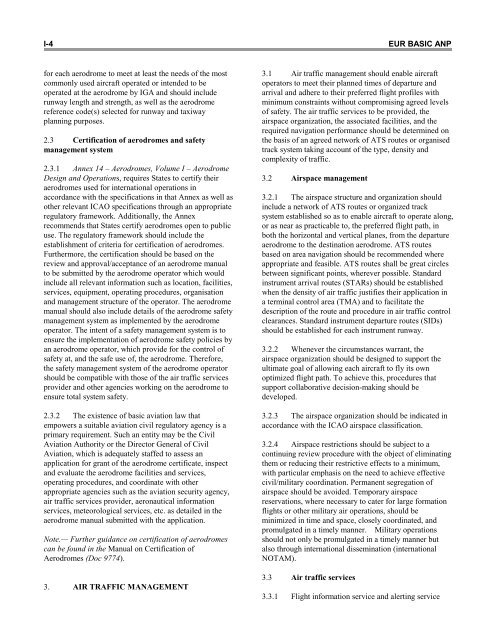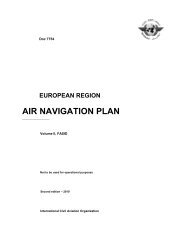7754 Vol 1 Flyleaf - ICAO Public Maps
7754 Vol 1 Flyleaf - ICAO Public Maps
7754 Vol 1 Flyleaf - ICAO Public Maps
You also want an ePaper? Increase the reach of your titles
YUMPU automatically turns print PDFs into web optimized ePapers that Google loves.
I-4 EUR BASIC ANP<br />
for each aerodrome to meet at least the needs of the most<br />
commonly used aircraft operated or intended to be<br />
operated at the aerodrome by IGA and should include<br />
runway length and strength, as well as the aerodrome<br />
reference code(s) selected for runway and taxiway<br />
planning purposes.<br />
2.3 Certification of aerodromes and safety<br />
management system<br />
2.3.1 Annex 14 – Aerodromes, <strong>Vol</strong>ume I – Aerodrome<br />
Design and Operations, requires States to certify their<br />
aerodromes used for international operations in<br />
accordance with the specifications in that Annex as well as<br />
other relevant <strong>ICAO</strong> specifications through an appropriate<br />
regulatory framework. Additionally, the Annex<br />
recommends that States certify aerodromes open to public<br />
use. The regulatory framework should include the<br />
establishment of criteria for certification of aerodromes.<br />
Furthermore, the certification should be based on the<br />
review and approval/acceptance of an aerodrome manual<br />
to be submitted by the aerodrome operator which would<br />
include all relevant information such as location, facilities,<br />
services, equipment, operating procedures, organisation<br />
and management structure of the operator. The aerodrome<br />
manual should also include details of the aerodrome safety<br />
management system as implemented by the aerodrome<br />
operator. The intent of a safety management system is to<br />
ensure the implementation of aerodrome safety policies by<br />
an aerodrome operator, which provide for the control of<br />
safety at, and the safe use of, the aerodrome. Therefore,<br />
the safety management system of the aerodrome operator<br />
should be compatible with those of the air traffic services<br />
provider and other agencies working on the aerodrome to<br />
ensure total system safety.<br />
2.3.2 The existence of basic aviation law that<br />
empowers a suitable aviation civil regulatory agency is a<br />
primary requirement. Such an entity may be the Civil<br />
Aviation Authority or the Director General of Civil<br />
Aviation, which is adequately staffed to assess an<br />
application for grant of the aerodrome certificate, inspect<br />
and evaluate the aerodrome facilities and services,<br />
operating procedures, and coordinate with other<br />
appropriate agencies such as the aviation security agency,<br />
air traffic services provider, aeronautical information<br />
services, meteorological services, etc. as detailed in the<br />
aerodrome manual submitted with the application.<br />
Note.— Further guidance on certification of aerodromes<br />
can be found in the Manual on Certification of<br />
Aerodromes (Doc 9774).<br />
3. AIR TRAFFIC MANAGEMENT<br />
3.1 Air traffic management should enable aircraft<br />
operators to meet their planned times of departure and<br />
arrival and adhere to their preferred flight profiles with<br />
minimum constraints without compromising agreed levels<br />
of safety. The air traffic services to be provided, the<br />
airspace organization, the associated facilities, and the<br />
required navigation performance should be determined on<br />
the basis of an agreed network of ATS routes or organised<br />
track system taking account of the type, density and<br />
complexity of traffic.<br />
3.2 Airspace management<br />
3.2.1 The airspace structure and organization should<br />
include a network of ATS routes or organized track<br />
system established so as to enable aircraft to operate along,<br />
or as near as practicable to, the preferred flight path, in<br />
both the horizontal and vertical planes, from the departure<br />
aerodrome to the destination aerodrome. ATS routes<br />
based on area navigation should be recommended where<br />
appropriate and feasible. ATS routes shall be great circles<br />
between significant points, wherever possible. Standard<br />
instrument arrival routes (STARs) should be established<br />
when the density of air traffic justifies their application in<br />
a terminal control area (TMA) and to facilitate the<br />
description of the route and procedure in air traffic control<br />
clearances. Standard instrument departure routes (SIDs)<br />
should be established for each instrument runway.<br />
3.2.2 Whenever the circumstances warrant, the<br />
airspace organization should be designed to support the<br />
ultimate goal of allowing each aircraft to fly its own<br />
optimized flight path. To achieve this, procedures that<br />
support collaborative decision-making should be<br />
developed.<br />
3.2.3 The airspace organization should be indicated in<br />
accordance with the <strong>ICAO</strong> airspace classification.<br />
3.2.4 Airspace restrictions should be subject to a<br />
continuing review procedure with the object of eliminating<br />
them or reducing their restrictive effects to a minimum,<br />
with particular emphasis on the need to achieve effective<br />
civil/military coordination. Permanent segregation of<br />
airspace should be avoided. Temporary airspace<br />
reservations, where necessary to cater for large formation<br />
flights or other military air operations, should be<br />
minimized in time and space, closely coordinated, and<br />
promulgated in a timely manner. Military operations<br />
should not only be promulgated in a timely manner but<br />
also through international dissemination (international<br />
NOTAM).<br />
3.3 Air traffic services<br />
3.3.1 Flight information service and alerting service














